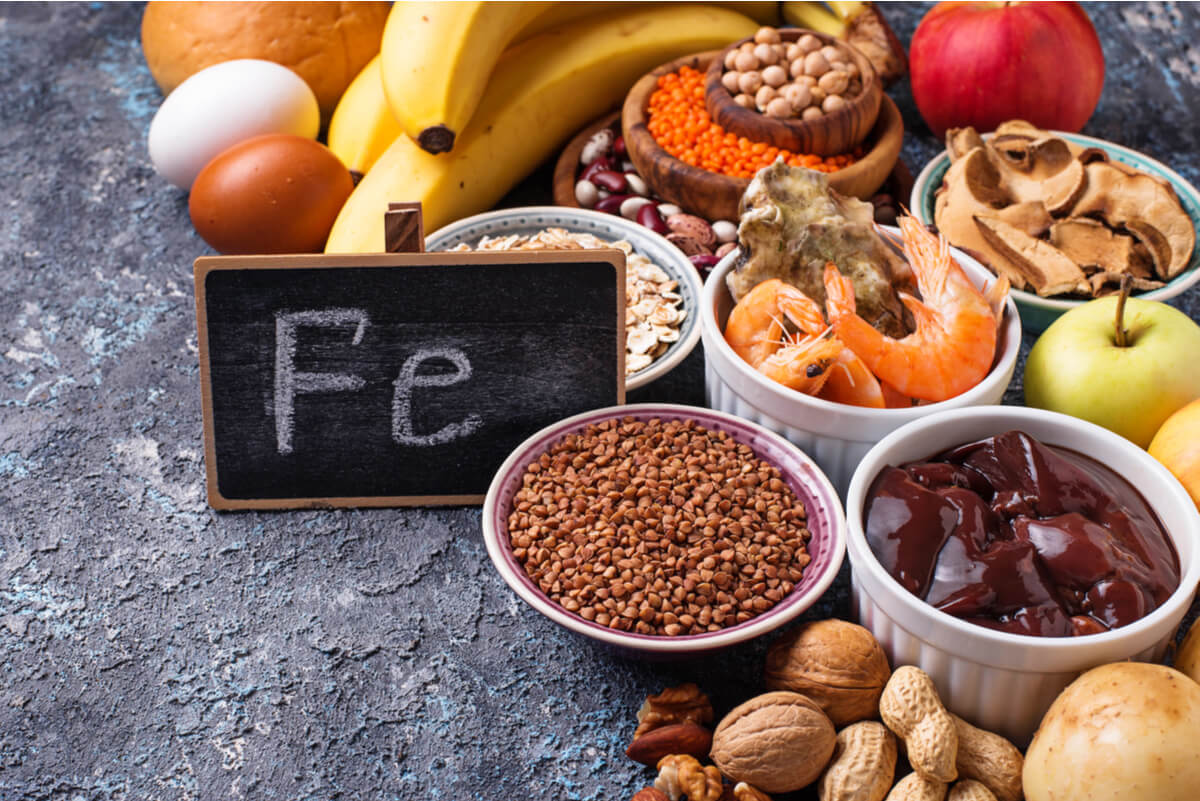Anemia in Pregnancy: Management Before, During and After

Iron deficiency anemia in pregnancy is a very common health problem. However, the good news is that it can be both prevented and treated. We will talk about the latter in more detail throughout this article.
The therapeutic management of anemia before, during and after pregnancy has a series of characteristics that must be taken into account. Above all, to understand the reason why not all measures applied to try to solve it are beneficial in all cases and, also, why it’s so important to follow the doctor’s instructions.
Iron deficiency anemia in pregnancy

We generally tend to think that, in the case of iron deficiency anemia, making some changes in the diet (such as eating red meat and lentils more frequently) and taking an iron supplement would be enough. However, it must be remembered that each case requires a series of specific steps.
The particularities of the management or approach to anemia aren’t only aimed at addressing the problem, but are also aimed at preventing complications that may harm the person’s quality of life or even put them at risk.
Iron is an essential nutrient for everyone’s health. Throughout her life, a woman may become deficient in iron for various reasons, such as heavy menstruation or pregnancy.
According to data from the World Health Organization, around 40% of pregnant women have anemia, and half of this figure is associated with an iron deficiency.
In the case of pregnancy, the body requires a greater amount of iron to be able to produce hemoglobin and highly oxygenated blood to promote the correct formation of the placenta and the fetus.
According to Dr. Alejandra Martínez Schulte, by trimester, the iron requirements of a pregnant woman’s body would be the following:
- First trimester: 1-2 mg/day of iron for normal gastrointestinal desquamation and early pregnancy-related increase.
- Second trimester: 4-5 mg/day due to requirements to increase maternal red blood cell production, fetal erythrocyte production, and fetoplacental growth.
- Third trimester: 6 mg/day due to ongoing maternal and fetal red cell production as well as fetoplacental growth.
Let’s see how to manage anemia in pregnancy, depending on the stage the woman is in.
Management of anemia before and during pregnancy

Women who know that they have a certain predisposition to suffer from iron deficiency anemia should take this into account when having medical check-ups and, above all, before seeking to get pregnant. In this way, the doctor will be able to indicate the best prevention strategy and monitor its progress.
Treating anemia in pregnancy effectively is essential for the health of the fetus and other aspects that include compensation for the expected blood loss during a normal delivery, among others.
Since anemia can have various causes and clinical manifestations, iron supplements aren’t always prescribed in the first instance. For this reason, it isn’t at all advisable to avoid consulting a professional.
In general, the management of anemia before and during pregnancy is similar. In this, changes in diet are usually favorable, but they aren’t the only possible solution. Everything will depend on the case.
- As the MSD Manual states: “About 20% of pregnant women don’t absorb enough iron orally; some of them require parenteral treatment.”
- In addition to including sources of iron more frequently in the diet, the consumption of these, along with sources of vitamin C, is recommended, as they improve their absorption. An example of this would be the combination of lentils and citrus juice, in one of the main meals.
If anemia is present in the second and third trimesters of pregnancy, the doctor may prescribe an oral iron supplement.
Management of anemia after pregnancy
In the management of anemia, once delivery has already taken place, it will be essential to prevent problems with the breastfeeding process and complications such as postpartum depression. Again, while a proper diet is valued, other measures could also be considered, which don’t always include iron supplementation.
Final recommendations
Ultimately, general recommendations (regarding diet and other lifestyle adjustments), along with appropriate treatment (depending on the stage of pregnancy the woman is in and the underlying cause of anemia) can help to solve anemia in pregnancy effectively.
But, in order to do this, it’s essential to follow the recommendations of your doctor.
If you suffer from fatigue and other discomfort, and you suspect that you may have anemia or some other health problem, or you simply have concerns and want to resolve them, then don’t hesitate to get a check-up and share all your worries with the specialist.
Iron deficiency anemia in pregnancy is a very common health problem. However, the good news is that it can be both prevented and treated. We will talk about the latter in more detail throughout this article.
The therapeutic management of anemia before, during and after pregnancy has a series of characteristics that must be taken into account. Above all, to understand the reason why not all measures applied to try to solve it are beneficial in all cases and, also, why it’s so important to follow the doctor’s instructions.
Iron deficiency anemia in pregnancy

We generally tend to think that, in the case of iron deficiency anemia, making some changes in the diet (such as eating red meat and lentils more frequently) and taking an iron supplement would be enough. However, it must be remembered that each case requires a series of specific steps.
The particularities of the management or approach to anemia aren’t only aimed at addressing the problem, but are also aimed at preventing complications that may harm the person’s quality of life or even put them at risk.
Iron is an essential nutrient for everyone’s health. Throughout her life, a woman may become deficient in iron for various reasons, such as heavy menstruation or pregnancy.
According to data from the World Health Organization, around 40% of pregnant women have anemia, and half of this figure is associated with an iron deficiency.
In the case of pregnancy, the body requires a greater amount of iron to be able to produce hemoglobin and highly oxygenated blood to promote the correct formation of the placenta and the fetus.
According to Dr. Alejandra Martínez Schulte, by trimester, the iron requirements of a pregnant woman’s body would be the following:
- First trimester: 1-2 mg/day of iron for normal gastrointestinal desquamation and early pregnancy-related increase.
- Second trimester: 4-5 mg/day due to requirements to increase maternal red blood cell production, fetal erythrocyte production, and fetoplacental growth.
- Third trimester: 6 mg/day due to ongoing maternal and fetal red cell production as well as fetoplacental growth.
Let’s see how to manage anemia in pregnancy, depending on the stage the woman is in.
Management of anemia before and during pregnancy

Women who know that they have a certain predisposition to suffer from iron deficiency anemia should take this into account when having medical check-ups and, above all, before seeking to get pregnant. In this way, the doctor will be able to indicate the best prevention strategy and monitor its progress.
Treating anemia in pregnancy effectively is essential for the health of the fetus and other aspects that include compensation for the expected blood loss during a normal delivery, among others.
Since anemia can have various causes and clinical manifestations, iron supplements aren’t always prescribed in the first instance. For this reason, it isn’t at all advisable to avoid consulting a professional.
In general, the management of anemia before and during pregnancy is similar. In this, changes in diet are usually favorable, but they aren’t the only possible solution. Everything will depend on the case.
- As the MSD Manual states: “About 20% of pregnant women don’t absorb enough iron orally; some of them require parenteral treatment.”
- In addition to including sources of iron more frequently in the diet, the consumption of these, along with sources of vitamin C, is recommended, as they improve their absorption. An example of this would be the combination of lentils and citrus juice, in one of the main meals.
If anemia is present in the second and third trimesters of pregnancy, the doctor may prescribe an oral iron supplement.
Management of anemia after pregnancy
In the management of anemia, once delivery has already taken place, it will be essential to prevent problems with the breastfeeding process and complications such as postpartum depression. Again, while a proper diet is valued, other measures could also be considered, which don’t always include iron supplementation.
Final recommendations
Ultimately, general recommendations (regarding diet and other lifestyle adjustments), along with appropriate treatment (depending on the stage of pregnancy the woman is in and the underlying cause of anemia) can help to solve anemia in pregnancy effectively.
But, in order to do this, it’s essential to follow the recommendations of your doctor.
If you suffer from fatigue and other discomfort, and you suspect that you may have anemia or some other health problem, or you simply have concerns and want to resolve them, then don’t hesitate to get a check-up and share all your worries with the specialist.
- Azami, Milad et al. “The association between anemia and postpartum depression: A systematic review and meta-analysis.” Caspian journal of internal medicine vol. 10,2 (2019): 115-124. doi:10.22088/cjim.10.2.115
-
Espitia De La Hoz F, Orozco l. 2013. “Anemia En El Embarazo, Un Problema de Salud Que Puede Prevenirse.” Revista de Los Estudiantes de Medicina de La Universidad Industrial de Santander, 2013. http://www.scielo.org.co/pdf/muis/v26n3/v26n3a05.pdf.
- Gonzales Gustavo F, Olavegoya Paola. Fisiopatología de la anemia durante el embarazo: ¿anemia o hemodilución?. Rev. peru. ginecol. obstet. [Internet]. 2019 Oct [citado 2021 Mayo 28] ; 65( 4 ): 489-502. Disponible en: http://www.scielo.org.pe/scielo.php?script=sci_arttext&pid=S2304-51322019000400013&lng=es. http://dx.doi.org/10.31403/rpgo.v65i2210.
- Martínez Sánchez LM, Jaramillo Jaramillo LI, Villegas Álzate JD, Álvarez Hernández LF, Ruiz Mejía C. La anemia fisiológica frente a la patológica en el embarazo. Rev Cuba Obstetr Ginecol [Internet]. 2018 [citado 28 May 2021];, 44(2):[aprox. 0 p.]. Disponible en: http://revginecobstetricia.sld.cu/index.php/gin/article/view/356
- Martínez, S, Alejandra. (2019). Anemia y embarazo. p. 9. Disponible en: https://www.researchgate.net/publication/341164046_Anemia_y_embarazo
Este texto se ofrece únicamente con propósitos informativos y no reemplaza la consulta con un profesional. Ante dudas, consulta a tu especialista.







